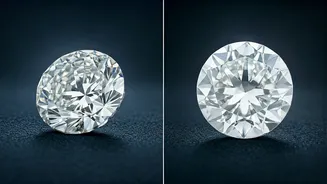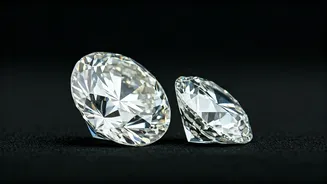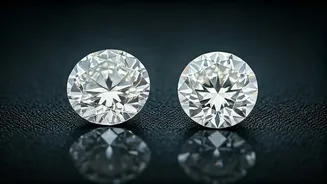Understanding Diamond Basics
To effectively differentiate between an American diamond and a natural diamond, it's crucial to first grasp the fundamentals of what constitutes a diamond.
Natural diamonds, prized for their brilliance and durability, are formed deep within the earth under intense heat and pressure. This process gives them a unique crystal structure. In contrast, an American diamond, often referred to as a diamond simulant, is created in a lab. The term 'American diamond' itself can be somewhat misleading, as it often refers to cubic zirconia (CZ), a synthetic gemstone. Therefore, understanding the origin and creation process of each type is the first step in differentiating them. This knowledge provides a foundation for recognizing their distinct features.
Brilliance and Sparkle
One of the most immediate ways to tell the difference is by assessing the brilliance and sparkle. Real diamonds are renowned for their exceptional sparkle. This sparkle is due to their high refractive index, which allows them to bend and reflect light in various directions. This gives natural diamonds an intense brilliance that is difficult to replicate. Conversely, cubic zirconia, a common American diamond, also reflects light, but its brilliance isn’t as dispersed. The light reflected from a CZ might appear more dispersed. By comparing the sparkle under the same lighting conditions, you can often discern which is the real diamond. The fire and brilliance of a real diamond will typically be more pronounced, with a more vibrant display of colors.
The Water Test
A simple water test can be a straightforward method for evaluation. Due to its density, a real diamond has a high specific gravity. This means that a genuine diamond sinks in water. Conversely, CZs, which are less dense, tend to float or sink very slowly. To perform this test, simply drop the gem into a glass of water. If the stone immediately sinks to the bottom, it could indicate a real diamond. However, it's essential to note that this test isn't foolproof and can be influenced by other factors like the cut or setting of the stone. Therefore, the water test is a useful initial indicator but should be combined with other tests for a more conclusive assessment.
Heat Test for Clarity
The heat test is another technique for differentiating between American and genuine diamonds, leveraging their responses to temperature changes. Real diamonds, known for their exceptional thermal conductivity, do not react in the same way as synthetic stones. When exposed to heat, a real diamond should not be significantly affected because it dissipates heat quickly. For the test, you can use a lighter to heat the stone for about 30 seconds. If the stone is a real diamond, it should not crack or change. A CZ, on the other hand, might react differently. Heat can cause internal expansion and, in some cases, lead to damage or cloudiness. Safety precautions are important, and the test should only be performed on stones that are not already set in jewelry.
Price and Cost Analysis
The price is often a primary clue that separates real diamonds from their simulated counterparts. Genuine diamonds are costly, their prices vary significantly based on factors like carat, clarity, cut, and color. These factors are known as the 4Cs. The rarity and formation process of diamonds contribute to their higher costs. In contrast, American diamonds or CZs, are far less expensive. Cubic zirconia is relatively cheap to produce, making it accessible to a wider market. If the price seems too good to be true, it likely is. Comparing prices with industry standards can provide strong insight into whether a stone is a natural diamond or a simulant. This should be combined with other tests to confirm the assessment.
The Loupe Examination
Using a loupe, a small magnifying tool, is an effective way to examine the internal structure of a gemstone. A real diamond often has natural inclusions, such as tiny imperfections or flaws, that formed during its creation deep within the earth. These inclusions are like fingerprints. CZs, however, are usually very clean internally, as they are manufactured under controlled conditions. When viewed with a loupe, CZs appear flawless, a clear indication that it is a lab-created stone. A diamond’s inclusions are often visible as small specks, clouds, or other unique patterns that reflect its natural origin. This test assists in identifying a gem’s true nature by examining its internal features.
Expert Gemologist Appraisal
For an absolute confirmation, consulting a gemologist is recommended. Gemologists have special tools and years of experience to test and assess gemstones. They can provide an authentic identification through professional analysis. Gemologists can examine the diamond with sophisticated instruments that help to verify the authenticity and grade diamonds accurately. They can also provide a certificate that specifies the gem's characteristics, like its cut, clarity, carat weight, and color, using the GIA grading system. This certificate offers reassurance of a diamond's authenticity, giving you a full understanding of the stone’s quality. This is especially helpful when making significant purchases, ensuring you have the confidence of a professional’s expert evaluation.











